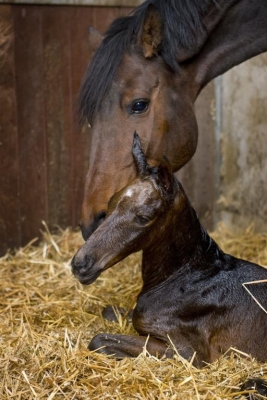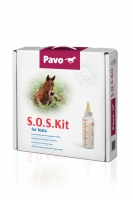|
Advice article filter
|
Foal coming: everything you need to know!Is there anything that gives more joy than a mare and foal in the pasture? The mare is in her final days before giving birth and the foaling is imminent. An exciting moment! But how do you know your mare is getting ready? And what is important during and just after the parturition? Pre-parturitionNot all mares in foal will equally show signs that the foaling is imminent. Typically, when your mare’s udder fills, a hollow develops on either side of the base of the tail, and wax-like beads appear on the end of each teat, foaling may only be hours away. Make sure that you have the following items ready or arranged in order to be optimally prepared for the foaling:
During the parturitionWhen the mare starts to give birth and the amniotic membrane is visible, check if the foal’s position is correct. Check if you can feel the two front legs and the head. If this is not the case, then the foal might be in a wrong position. Make your mare stand up and call the vet immediately. The first 24 hours after parturitionThe first 24 hours in the life of a foal are crucial. It is important that you check a number of issues (see table 1 below). After the birth, for resistance to diseases, the foal is completely dependent on the antibodies in the first mare’s milk, also called colostrum. Only during the first 24 hours, the antibodies can pass through the foal’s intestinal wall and be absorbed in the bloodstream. If the foal does not want to drink, if the mare suffers from mastitis or has died, then frozen colostrum or the Pavo S.O.S-kit containing artificial colostrum can offer a solution if it really is not working. Table 1: What happens with a healthy foal? A healthy foal within: Stands < 1-2 hours Nurses < 2-4 hours Urinates < 8 hours Intake of moisture < 12 hours Pass the meconium < 12-24 hours An orphan foalIt is the nightmare of every breeder: problems during the birthing. Should the mare or the foal not survive the birthing, than check the Facebook page of the Foster Mares and Orphan Foals UK. Through this page, you can try to arrange an adoption. Should you need a surrogate mare that has lost her foal, then check what the cause was. If a disease is suspected, it is better not to place a foal. Make good arrangements prior to the placement and put them in writing. Weaning the foalMost foals are weaned between five and six months of age, when it eats independently foal pellets and roughage. Read here more about feeding the foal. In order to allow the lactation to dry up gradually, it is wise to reduce the quantity of concentrates of the mare by half. Three days before the planned weaning, the concentrate feed should be tapered off all together. Ensure the mare gets sufficient exercise too. Deworming the foalIt is advisable to deworm the foal between day four and day eight. This should be repeated after four to six weeks. After that, in consultation with your vet, a normal deworming program can be maintained. Note well: the deworming paste should be appropriate for foals. |



